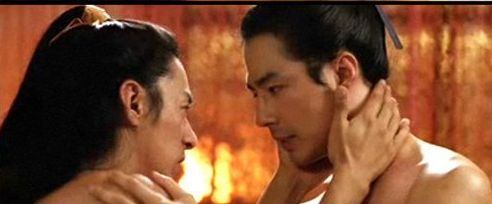Young-Gwan Kim and Sook-Ja Hahn's Homosexuality in ancient and modern Korea gives us a quick academic read on, well, homosexuality in ancient and modern Korea. The abstract:
This paper examines Korean views on the subject of male homosexuality. Using historical and contemporary sources, it seeks to explain elements of new cultural openness towards homosexuality in modern Korea. Korean people’s understanding and knowledge of male homosexuality is ambiguous and limited. In the absence of knowledge and open communication, most Korean people imagine that male homosexuality is an abnormal and impure modern phenomenon. Prejudice and confusion lead most Korean male homosexuals to be estranged from their families, religious communities and non-homosexual peers. Moreover, they are often viewed as the ‘carriers’ of AIDS and Sexually Transmitted Diseases (STDs). The purpose of this paper is to examine current Korean perspectives on male homosexuality by exploring both the ancient history of the practice of male homosexuality and current thinking about homosexual life among Koreans, which has played an important part in the formation of contemporary attitudes toward homosexuality.
The article, published in 2006 in Culture, Health, and Sexuality, looks at traditional Confucian views of the family, hwarang and their same sex relations in the Silla dynasty and modern homosexual life in Korea. I've heard most of this before, but did learn about yongyang-chi-chang (the dragon and the sun), which is apparently what homosexual pairing was called under the Goryeo dynasty. Two masculine symbols getting it on.
The quick ten-minute read is all available online.
This paper examines Korean views on the subject of male homosexuality. Using historical and contemporary sources, it seeks to explain elements of new cultural openness towards homosexuality in modern Korea. Korean people’s understanding and knowledge of male homosexuality is ambiguous and limited. In the absence of knowledge and open communication, most Korean people imagine that male homosexuality is an abnormal and impure modern phenomenon. Prejudice and confusion lead most Korean male homosexuals to be estranged from their families, religious communities and non-homosexual peers. Moreover, they are often viewed as the ‘carriers’ of AIDS and Sexually Transmitted Diseases (STDs). The purpose of this paper is to examine current Korean perspectives on male homosexuality by exploring both the ancient history of the practice of male homosexuality and current thinking about homosexual life among Koreans, which has played an important part in the formation of contemporary attitudes toward homosexuality.
The article, published in 2006 in Culture, Health, and Sexuality, looks at traditional Confucian views of the family, hwarang and their same sex relations in the Silla dynasty and modern homosexual life in Korea. I've heard most of this before, but did learn about yongyang-chi-chang (the dragon and the sun), which is apparently what homosexual pairing was called under the Goryeo dynasty. Two masculine symbols getting it on.
 |
| Dragon and Sun (from A Frozen Flower) |


Recent comments